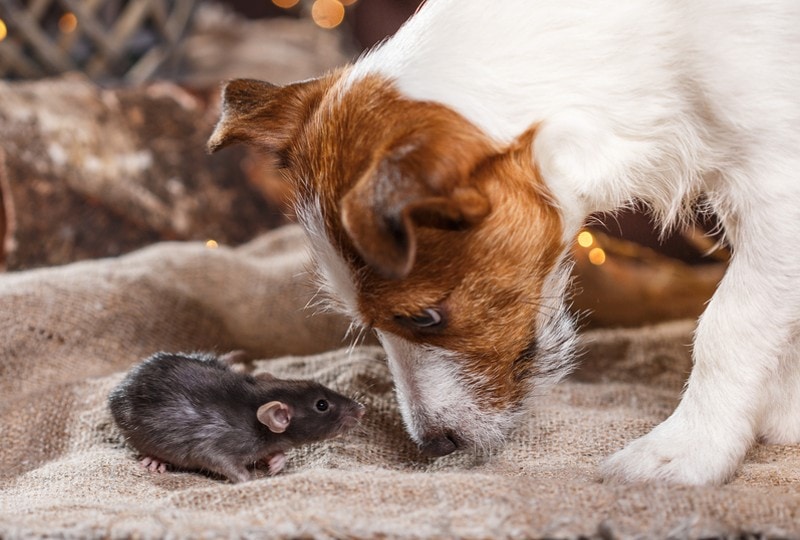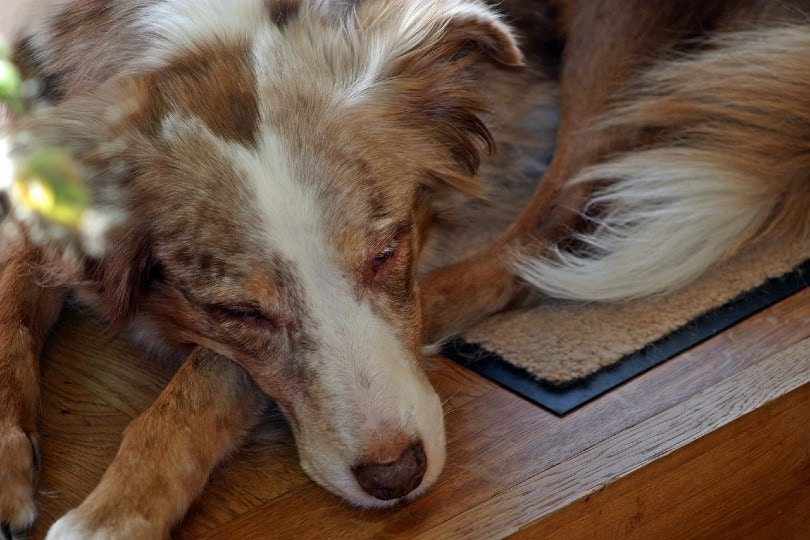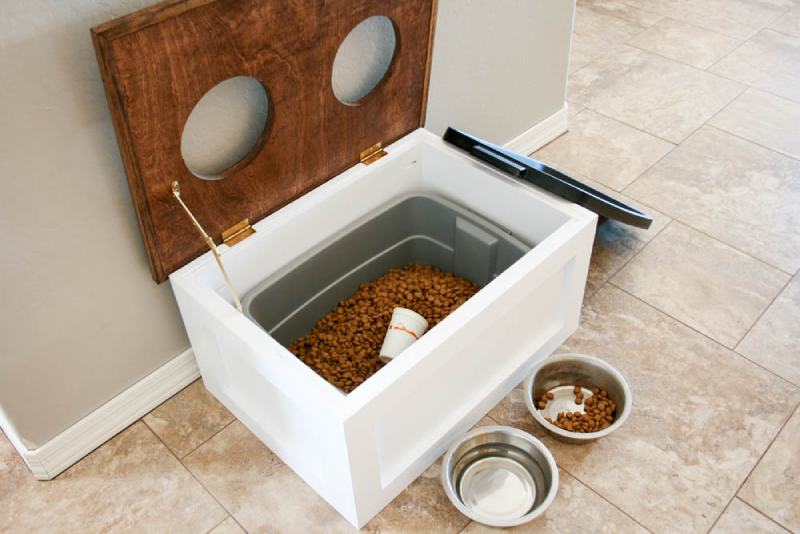My Dog Killed a Rat! 6 Tips on What to Do Next

Updated on

If you’ve recently found your dog proudly carrying around a dead rat, you may be wondering if this is normal behavior. The short answer is yes—it’s perfectly natural for dogs to hunt and kill rats. But if you’re concerned about whether or not your dog is at risk of catching a disease from the rat, or if you have a rat problem in your home, read on for some tips on what to do next.
The 5 Tips on What to Do When Your Dog Killed a Rat
1. Don’t Panic!
There’s no denying that dogs have a predatory nature. After all, they are descended from wolves—one of the top apex predators in the animal kingdom. However, this doesn’t explain why domesticated dogs kill rats, even though they’ve been bred to be human companions, not hunters. There are many common breeds of dogs that were trained and bred especially to exterminate rats.
Probably the most common and well-known breeds today are the terriers—generally small dogs with inquisitive, feisty characters that don’t back down from a fight. Even though these dogs are now domesticated, they still have that strong hunting instinct and the thrill of the chase. While it may be disturbing to us as pet owners, we must remember that this is part of a dog’s nature. As long as your dog isn’t putting themselves or others in danger while hunting rats, it is perfectly natural and there’s no need to worry about their behavior.

2. Deal with Your Rat Problem
Rats breed like…rabbits. Actually—they breed faster than rabbits, so if you don’t deal with rats when they first move in you will very soon be dealing with a much bigger infestation. You may have to get the exterminators in to handle your rat problem. However, you could also consider getting a cat to team up with your dog to create a formidable duo. In a 2017 study, the University of Florida Institute of Food and Agricultural Sciences found that having either a dog or a cat doesn’t significantly reduce the rat activity around a property, but pairing the two together sends fear into rats and causes them to avoid their nemeses’ home turf.1
3. Don’t Let Your Dog Eat the Rat
Your dog may have killed the rat, but that doesn’t mean that the rat wasn’t already dying and may be dangerous to your dog. After a rat eats poison, it can take 2–3 days to die, during which time it will be getting slower and slower, making them easier for a dog to catch. If your dog eats a poisoned rat, then they too will have ingested poison and could become sick. So, when you discover your dog has killed a rat, try and get the rat away from them quickly and quietly, avoiding any tussle with your dog over their kill.

4. Clean Up
You should dispose of the dead rat and clean up any mess avoiding direct contact with the rat and its blood. If you think your dog has eaten a dead rat—either partially or whole—the first thing you should do is call your veterinarian. They will likely want to bring your dog in for an examination and may even induce vomiting to get the rat out of their system. In some cases, dogs can die from eating a poisoned or diseased rat so it’s important to act fast and get professional help.
5. Keep an Eye on Your Dog
Although your dog may not have eaten a rat, they have still touched the rat either during the chase or in their mouth when they killed it. Depending on how your dog killed the rat there may have been blood spilled as well. Rats carry a plethora of harmful parasites, bacteria, and viruses, and, whilst rat-to-dog transmission of diseases is rare, it does happen.
The 4 Potential Diseases Carried in Rodents
The CDC lists over 25 diseases humans can catch directly or indirectly from rodents; here are the diseases we should be most worried about for our dogs
1. Leptospirosis (aka Weil’s Disease)
Leptospirosis is a disease that affects both dogs and rats. It is caused by a bacteria called Leptospira interrogans, which is found in water and soil. Leptospirosis is a serious disease that can be deadly for dogs. Symptoms include fever, vomiting, diarrhea, weakness, and muscle pain. If you think your dog may have been exposed to leptospirosis, take them to the vet immediately. Rats usually do not show any symptoms of the disease. Dogs can be infected with leptospirosis from rats in a few different ways. The most common way is for a dog to come into contact with rat urine, either through drinking contaminated water or walking in it. The bacteria live inside a rat’s kidneys so when a dog kills a rat or eats a rat, they might become infected.

2. Tularemia or “Rabbit Fever”
Tularemia is a serious bacterial infection that affects animals and humans. The bacteria that cause tularemia are found in many animals, including rodents, rabbits, hares, and deer. Tularemia can be spread to dogs through contact with these infected animals. Dogs can become infected by killing or eating infected rats. Rats can also infect dogs by biting them or infecting a dog’s water bowl. Symptoms of tularemia in dogs include fever, lethargy, weight loss, and diarrhea.
If your dog shows any of these symptoms, it’s important to see a veterinarian right away. Early diagnosis and treatment are essential for a full recovery.
3. Rat Bite Fever
In North America, rat bite fever is caused by the bacteria Streptobacillus moniliformis which can live in a rat’s upper respiratory tract. Rat bite fever can be transmitted to humans and dogs through the bite of an infected rat. Symptoms in dogs include fever, lethargy, loss of appetite, and joint pain. Dogs can catch rat bite fever from eating infected rats, coming into contact with infected rat feces, or being bitten by an infected rat. Whilst potentially fatal, typically rat bite fever is not dangerous to humans, but it can cause serious illness in young children, the elderly, and those with weakened immune systems.
4. Toxoplasmosis
Toxoplasmosis is a disease caused by an infection of the single-cell parasite toxoplasma gondii. The parasite is found in many animals, including rats, and can infect dogs and humans. Dogs are most likely to catch it by eating something infected with it, which certainly includes dead rats. Symptoms of toxoplasmosis in dogs include fever, lethargy, and loss of appetite. In severe cases, the disease can be fatal. Treatment for toxoplasmosis generally includes antibiotics and supportive care.
Conclusion
In conclusion, it’s natural for dogs to kill rats and there is no need to be alarmed. However, it’s important to note that rats breed prolifically and where there is one rat there will be more. Although rats are carriers of many diseases, they are not usually highly transmissible. Nevertheless, you should keep an eye on your dog and if you have any concerns, you should take your dog to be checked out by your veterinarian, especially if they have eaten the rat.
- See Also: My Dog Have Killed a Possum!
Featured Image Credit: dezy, Shutterstock












